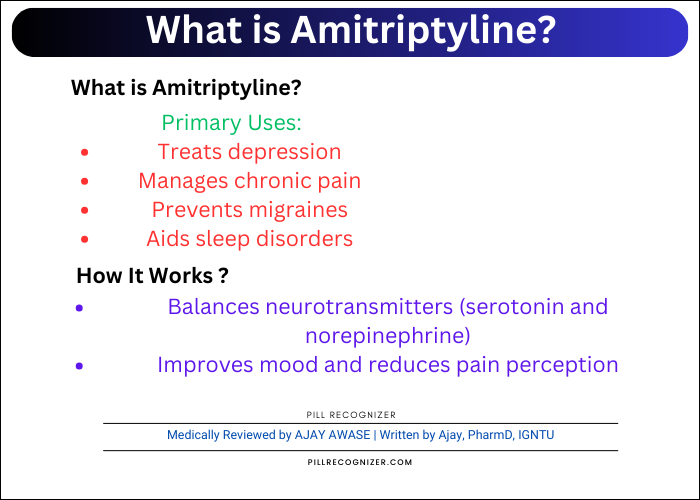Amitriptyline Guide: 5 Key Uses, 4 Benefits, and 3 Potential Side Effects for Effective Treatment
Amitriptyline Guide: 5 Key Uses, 4 Benefits, and 3 Potential Side Effects for Effective Treatment
Table of Contents
- Amitriptyline Guide: 5 Key Uses, 4 Benefits, and 3 Potential Side Effects for Effective Treatment

Introduction
What is Amitriptyline?
Tricyclic antidepressants (TCAs), such as amitriptyline, are mostly prescribed to address mental health issues and specific chronic pain illnesses. It was initially created to treat depression, but because of its special qualities, it can also be used to treat a wide range of other diseases.
How to use Amitriptyline HCL
Before beginning amitriptyline therapy and each time you receive a refill, read the Medication Guide that your pharmacist has provided. See your physician or pharmacist if you have any queries.
As your physician prescribes, take this medication orally one to four times daily. Take it at bedtime if you only take it once a day to help minimize daytime tiredness. Your medical condition and response to treatment will determine the dosage.
In order to mitigate the possibility of adverse reactions (including somnolence, parched lips, and lightheadedness), your physician could advise you to begin taking this drug at a lower dosage and progressively raise it. Pay close attention to your doctor’s recommendations.
To maximize the therapeutic effects of this drug, take it on a daily basis. Take it at the same time(s) every day to aid in memory. Don’t take this medication for longer than recommended, or raise your dosage. There will be no faster improvement in your health, and there will be a higher chance of adverse effects.
Even if you feel well, continue taking this medication. Never discontinue using this drug without first talking to your physician. Stopping this medication abruptly may make certain conditions worse. Additionally, symptoms like fatigue, headaches, mood swings, and altered sleep patterns may manifest. Your doctor may gradually lower your dose to avoid these symptoms while you are terminating this medication. For further information, speak with your pharmacist or physician. Please report immediately any new or worsening symptoms.
This medicine might not take effect straight away. Within a week, you might start to feel some improvement. . It can take up to four weeks, though, before you experience the full effects.
Inform your physician if your condition persists or worsens (for example, if you experience increasing levels of melancholy or suicidal thoughts).
Why is Amitriptyline Used?
Amitriptyline is prescribed for its ability to improve mood, alleviate pain, and promote better sleep. Its versatility makes it a go-to medication for many healthcare providers.
Uses of Amitriptyline
Treating Depression
Treating major depressive illness with amitriptyline is a frequent practice. It ameliorates depressive symptoms and improves mood by restoring neurotransmitter balance in the brain.
Here’s how Amitriptyline can help treat depression:
- Improves mood: Amitriptyline can help to improve your mood and reduce feelings of sadness and hopelessness.
- Increases energy levels: It might make getting out of bed in the mornings simpler and help you feel more energised.
- Reduces symptoms of depression: Other symptoms of depression, like changes in appetite, difficulties sleeping, and loss of interest in activities, can be lessened with the use of amitriptyline.
Managing Chronic Pain
Millions of individuals worldwide suffer from chronic pain, which has a major negative influence on their quality of life. Tricyclic antidepressant amitriptyline has shown promise in treating a range of chronic pain syndromes. This blog examines the advantages of amitriptyline for pain management as well as key factors to take into account before starting this treatment.
Comprehending Chronic Pain
Pain that lasts longer than three months is referred to as chronic pain, and it is frequently brought on by diseases like fibromyalgia, neuropathy, arthritis, or other underlying medical illnesses. When conventional pain management techniques don’t work well, medical professionals may look into non-traditional options like amitriptyline.
How Amitriptyline Works for Pain Relief
Amitriptyline helps manage chronic pain through several mechanisms:
- Modulating Neurotransmitters: Neurotransmitters like norepinephrine and serotonin, which are important for controlling mood and pain perception, are affected in terms of their levels.
- Reducing Pain Signals: Amitriptyline can help reduce an individual’s level of pain by changing the way the brain interprets pain signals.
- Promoting Relaxation: Because people with chronic pain frequently experience disturbed sleep, its calming qualities may assist enhance sleep quality, which will enhance overall pain management.
Treating Migraine Headaches
Amitriptyline is often prescribed as a preventive treatment for migraines. It can decrease the frequency and intensity of migraine attacks by affecting certain neurotransmitters involved in pain pathways.
Benefits of Amitriptyline in Treating Migraine Headaches
Amitriptyline, a tricyclic antidepressant, is widely used for migraine prevention due to its multiple benefits:
- Reduced Frequency: It can greatly reduce the frequency of migraine episodes, which will lessen the disturbances to day-to-day activities.
- Less Severe Attacks: When migraines happen, many people have fewer severe symptoms and shorter pain periods.
- Improved Sleep Quality: Its calming qualities help reduce migraine triggers and encourage better sleep, which is essential for general health.
- Addressing Co-occurring Symptoms: Amitriptyline also aids in the management of melancholy and anxiety, which are prevalent among migraineurs and can assist lessen triggers even more.
- Non-Opioid Option: As a safe substitute for opioids, it reduces the possibility of dependence and adverse effects.
- Easy to Administer: Amitriptyline is usually taken at night and is easy to include into a schedule for regular, consistent use.
All things considered, amitriptyline is a great choice for anyone looking to manage their migraines effectively and live a better life.
Treating Nocturnal Enuresis (Bedwetting)
Amitriptyline is a medication that can be used to treat nocturnal enuresis in children and adolescents. By affecting sleep patterns and bladder function, this medication can help minimize bedwetting incidents.
Benefits of Amitriptyline
Improving Mood and Well-being
Amitriptyline’s ability to improve mood and relieve the emotional turmoil linked to depression and anxiety is one of its most important advantages.
Reducing Depressive Symptoms
After starting amitriptyline, patients frequently report feeling less depressed, hopeless, and tired, which improves their mental health overall.
Managing Chronic Pain
Amitriptyline can reduce discomfort and enhance everyday functioning for those with chronic pain disorders by changing the way the brain interprets pain.
Promoting Sleep
Due to its sedative qualities, amitriptyline is beneficial for those with insomnia or irregular sleep patterns, which improves the quality of their sleep in general.
Side Effects of Amitriptyline
Common Side Effects
Some common side effects of amitriptyline include dry mouth, drowsiness, dizziness, constipation, and weight gain. These effects can often diminish over time.
Potential Side Effects of Amitriptyline
- Sleepiness: This may cause drowsiness or sedation.
- Vertigo: This can lead to feelings of dizziness or spinning.
- Dry mouth: This may cause dryness and discomfort in the mouth.
- Impaired vision: Can affect vision clarity.
- Constipation: This may lead to difficulty passing stools.
- Weight gain: This can contribute to weight gain.
- Difficulty urinating: This may cause problems with urination.
If you experience any of these side effects, contact your healthcare provider.
Additional Tips:
- Get up slowly: To avoid dizziness, rise slowly from a sitting or lying position.
- Manage dry mouth: Drink water, chew sugar-free gum, or use a saliva substitute.
- Prevent constipation: Consume fiber-rich foods, stay hydrated, and exercise regularly. If needed, consult your pharmacist about suitable laxatives.
Serious Side Effects
Serious adverse effects are rare, but they can still happen. Suicidal thoughts, severe allergic reactions, and irregular heartbeats are a few examples. It is imperative to keep an eye out for any odd behavioral or emotional shifts.
Precautions and Warnings
To prevent potential risks, patients should talk to their healthcare practitioner about their medical history and current drugs before commencing amitriptyline.
Dosage and Administration
Typical Dosage
The ailment being treated can affect the amitriptyline dosage. The usual starting dose for depression is 25–50 mg per day, though this can be changed as necessary.
How to Take Amitriptyline
Usually taken orally, amitriptyline can be used with or without meals. For the best outcomes, it’s critical to carefully follow your healthcare provider’s directions.
Adjusting Dosage
Only a physician should be consulted when changing a patient’s dosage. Seek advice from your healthcare practitioner if the drug isn’t working or if there are serious adverse effects.
Interactions with Other Medications
Medications to Avoid
A number of drugs, including as monoamine oxidase inhibitors (MAOIs), various antidepressants, and medications that alter heart rhythm, might interact adversely with amitriptyline. Never withhold information from your doctor on the use of any supplements or drugs.
Potential Drug Interactions
Amitriptyline should not be taken with sedatives, alcohol, or other CNS depressants since this may increase the risk of drowsiness and other side effects.
Conclusion
Key Takeaways
Amitriptyline is a multipurpose drug that works well for treating migraines, depression, chronic pain, and bedwetting. Despite the fact that it has many advantages, possible interactions and negative effects need to be closely watched.
When to Consult a Doctor
See your healthcare practitioner as soon as possible if you have serious side effects, strange mood swings, or questions about your treatment plan. Your health comes first, and you have the option to modify your care to get the best results possible.
Government Websites: Resources
- Food and Drug Administration (FDA): https://www.fda.gov/
- National Institutes of Health (NIH): https://www.nih.gov/
END


